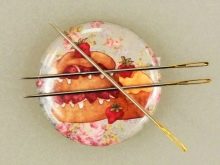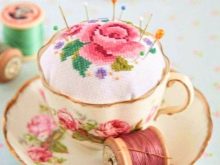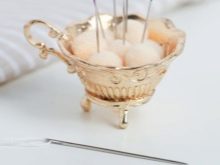Variety and selection of sewing needles
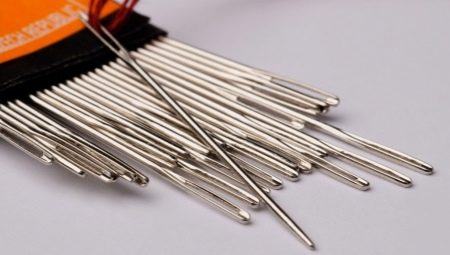
Archaeologists claim that needles appeared in people as early as the Paleolithic era. Varieties of the modern type were invented in the 14th century, when the production of wire was established using the drawing technique, they were brought to Russia by Peter I. Today they have become an integral part of the tailoring craft.

general description
Sewing was and remains one of the favorite types of needlework. In this work, you cannot do without needles. There are many operations that can only be performed manually:
- connecting workpieces together before stitching them on a sewing machine - usually this is how they work with large parts that, without preliminary sweeping, slide and move relative to each other all the time, as a result, the seam comes out sloppy;
- basting small workpieces to large ones - this type of work is especially common when sewing lining;
- registration of frills, darts and tucks, which require the obligatory marking of the folded edge;
- overcasting the edges of the fabric in order to prevent it from shedding;
- blind stitching when hemming;
- sewing on buttons, beads and other decorative elements to the finished product.
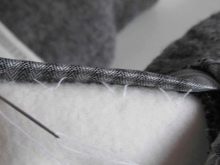
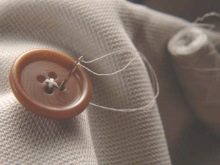
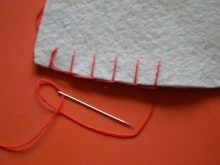
Tailors usually purchase hand-sewing kits. As a rule, they include 6 or 20 needles, a specific option is selected taking into account the type of work and the type of fabric. The more capricious the canvas is, the thinner and sharper the needle is needed. This fully applies to chiffon and other thin fabrics, where untidy holes may remain after punctures with a needle.
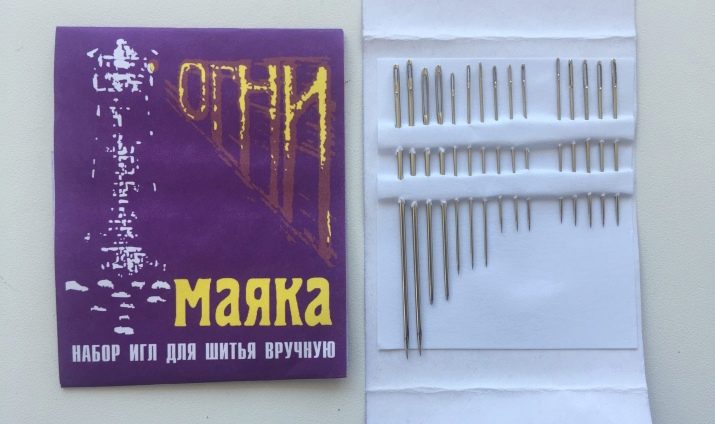
A completely different matter is the creation of jackets, drape coats, jeans and leather.In this case, you will need a set of needles of different types, which differ in the size of the eyelet, as well as in the length of the rod.
Species overview
Individual tailoring involves a large number of manual operations. Usually craftswomen sew many seams - for this they use the most common sewing needle. However, such accessories in stores are presented in a wide range, they differ in their purpose.
Universal
These are sharp needles of medium size with a compact eye. They are in demand when it is necessary to sweep the fabric or grind off parts before sewing the machine. Usually in the arsenal of any housewife there are 5-10 such needles - even if she is not keen on needlework. Their sizes range from 1 to 12.

For finishing parts and lining stitches
Medium or short needles are suitable for this type of work. This length is considered the most convenient for manual finishing of individual workpieces and the formation of a lining stitch. Sizes also vary from 1 to 12, the eye is round, small.
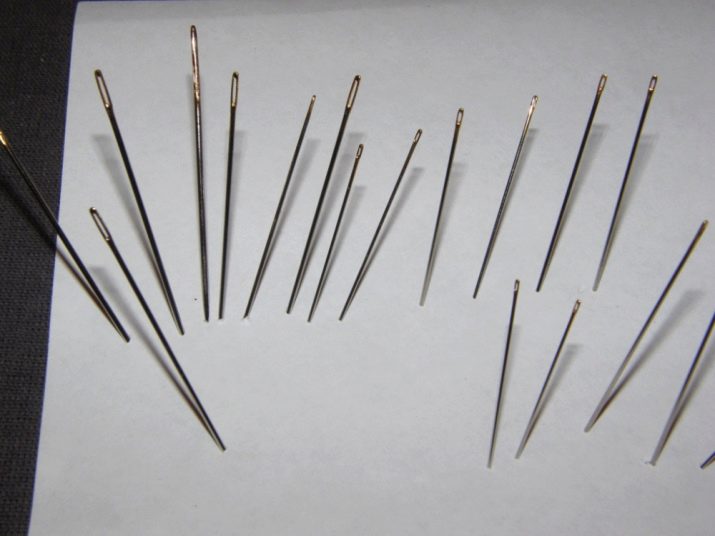
For work with knitwear
Knitwear is one of the most capricious materials, as it stretches during processing. That is why needles with a rounded end are considered the most practical.

It is very important that the point is blunt and the needle is thin, otherwise the materials may be damaged.
For hats
This type of needle is in demand in the manufacture of hats. They allow you to sketch, grind elements and form assemblies. These manipulations are possible only when using a thin elongated instrument with a rounded eye. Thickness - from 1 to 10.
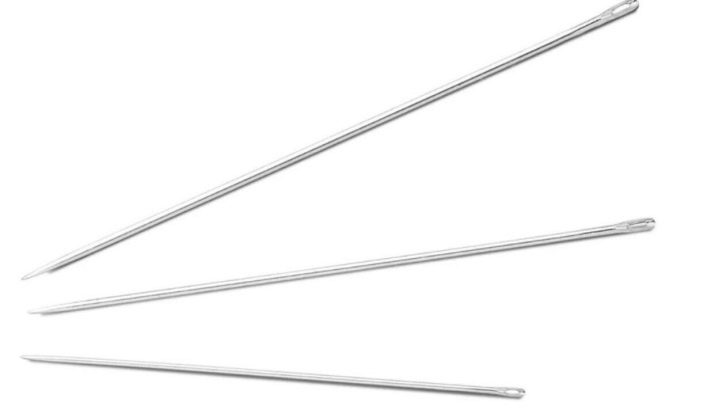
For working with fluffy and bouclé fabric
Thick needles with the shortest possible shaft are suitable for sewing this fabric. The tip must be pointed, and the ear must be large. The size range is 13-22.
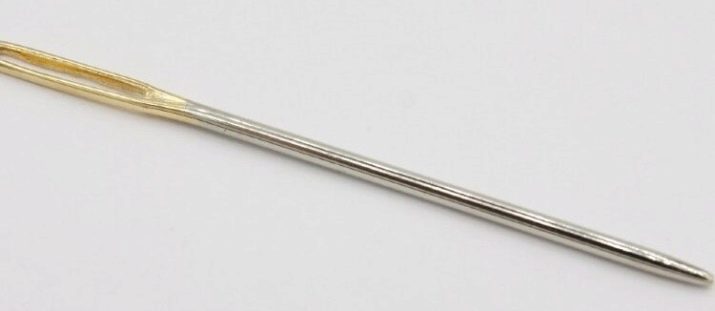
For decorative materials
Curved and semicircular needles are suitable for decorative fabrics. Sometimes, before completing hand sewing, just such a tool is used. - the curved shape allows you to make punctures even in the most difficult-to-reach areas, and the semicircular varieties seem to continue the movement of the hand during the sewing process. Therefore, any professional craftswoman who is engaged in the repair of old furniture should definitely have a similar sewing accessory on hand. The size range varies from 5 to 20.
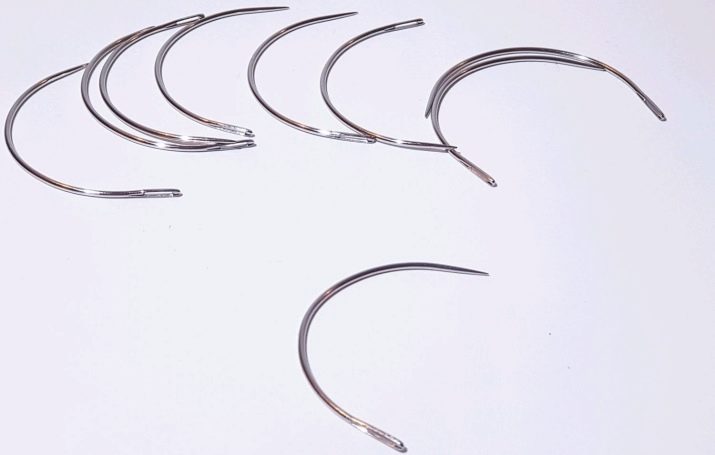
For darning
For darning, you need a needle with a large round eye so that you can easily pass several threads through it at once. Wherein the length must be sufficient to pull off the opposite edges of the gap in one pass, even when it has a significant area. Available in sizes from 1 to 10, as well as from 15 to 20.
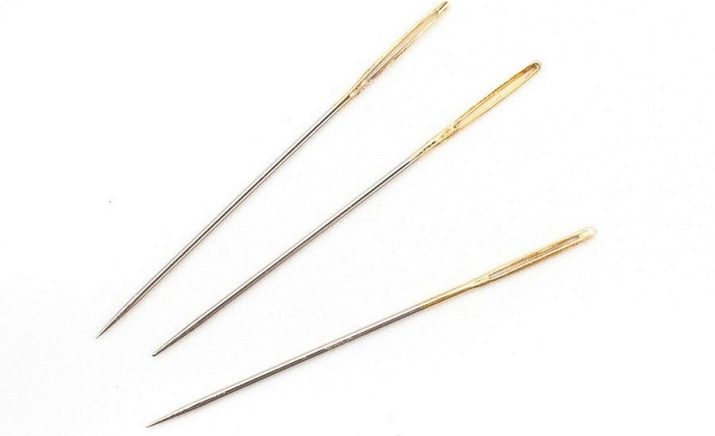
For visually impaired people
For visually impaired users, needles with a carbon self-winding eye are offered, it is distinguished by a double shape. The bottom looks normal, the top has a slot. The mechanism for threading such a needle is as follows: the thread is thrown over the end of the upper hole with a slot, and then pressed down with effort and threaded into the eyelet.
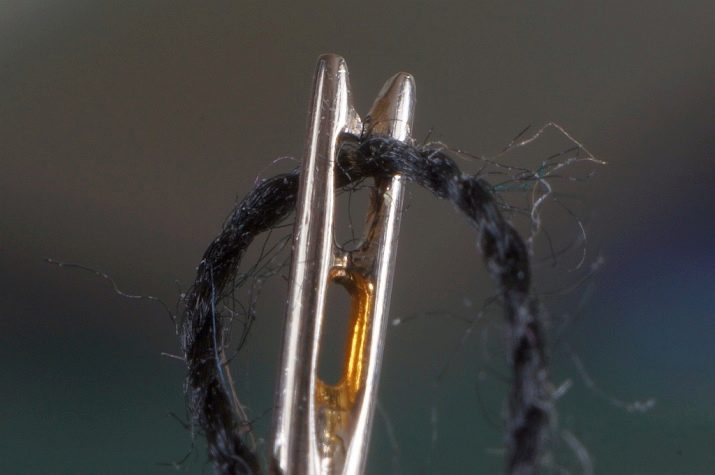
In this case, the size range is limited to four numbers.
For embroidery
Short needles with a large eye are suitable for embroidery. This hole allows you to thread several threads at once or thick woolen threads. The length of such needles is 3.5–4, the numbering is from 0 to 2.
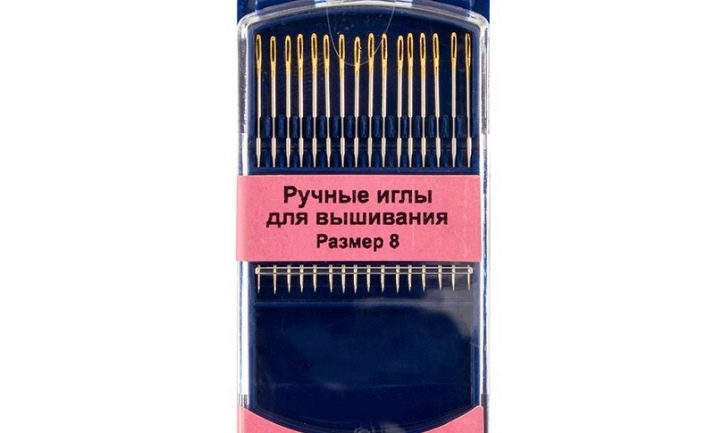
For embroidery on delicate fabrics (cambric with silk), needles with a small eye are suitable, thick ones will leave visible holes in the puncture areas. In addition, if the eyelet is too large, it will not hold too thin a thread. To create embroidery with beads, the thinnest needles with a miniature eye are used.
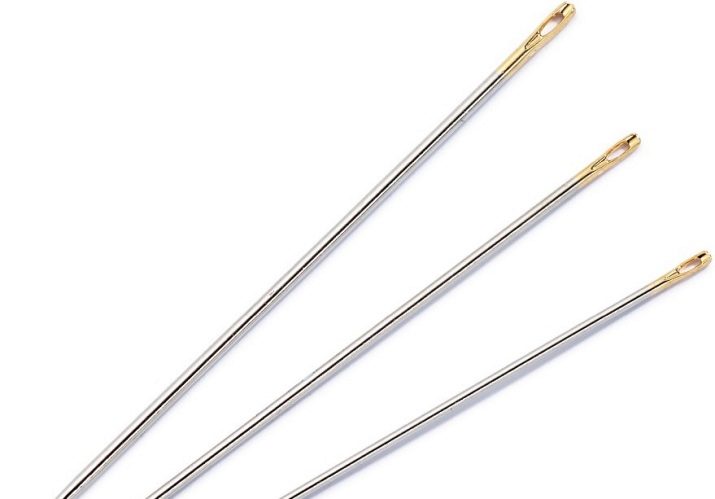
For skin
Leather needles are used for sewing jackets, shoes and bags. They belong to the category of furrier tools, without which it is not possible to cope with genuine leather.... The difficulty lies in the fact that the structure of this material does not contain threads through which a needle and thread could be threaded. The skin has to be literally pierced, and the thicker it is, the more physical effort will have to be made. Only needles with a triangular point can cope with such a difficult task, the size range is from 1 to 9.
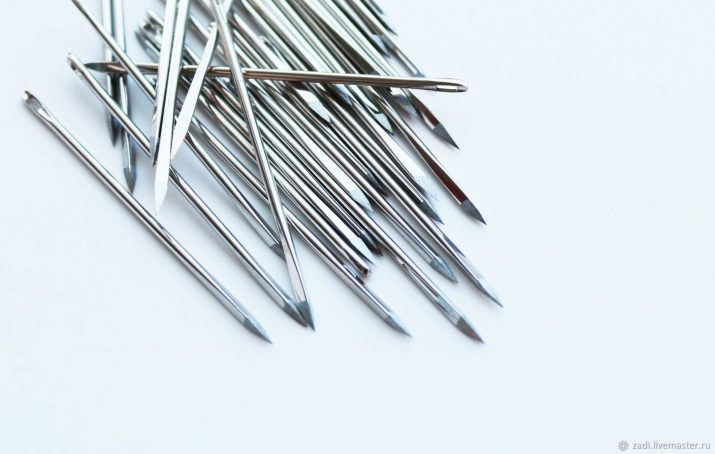
For decorating with beads
For stringing medium-sized pearls or beads, long and very thin needles are used. Their length should be such that they can accommodate as many ornaments as possible. In this case, the eyelet should be as small as possible so that you can work with beads of different sizes.
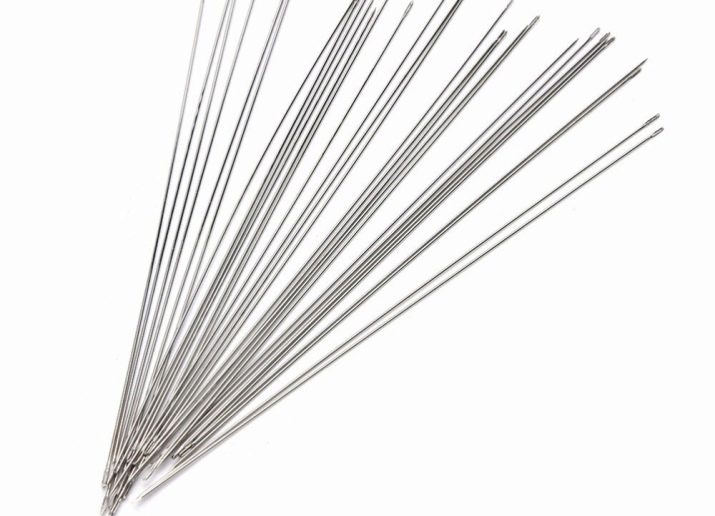
For dolls
For sewing soft toys use needles of medium length No. 9-15 with an elongated eye. Usually, such needles are used when it becomes necessary to give a rag doll the desired shape or to depict the necessary expression on the face. They are not suitable for striking individual elements of a toy.
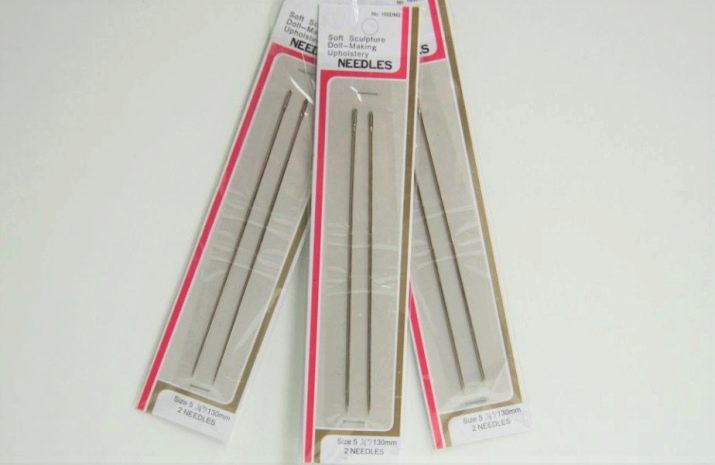
There are several other special types of needles.
- Sack - Relevant for sewing up bags and lining boxes with fibrous fabric. Such needles are distinguished by a four-sided sharpening, it is slightly flattened and bent upward by 30 degrees. The length of the needles is from 12 to 16 cm.
- Sailing - irreplaceable when a raincoat fabric, a membrane and other dense fabrics are used when sewing. These are needles with a sharpened point, they have three edges. Length - 6-7.
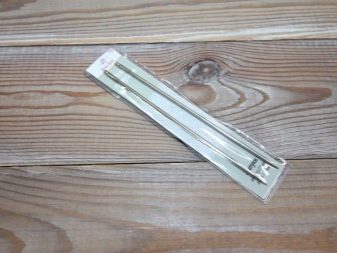
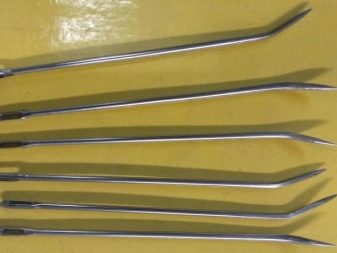
Selection Tips
When choosing needles, be sure to make sure of their high quality in the store. They should not be bent unless provided by the model. Chips, cracks and other defects are not allowed. Do not buy previously used by someone - with a high degree of probability they are already dull and will not be able to cope with their tasks.
Remember, needles need to be replaced periodically with new ones. It is completely inexpensive, so it will not create a serious burden on the craftswoman's budget. And of course, when choosing 1 set of needles, give preference to products from reliable manufacturers.
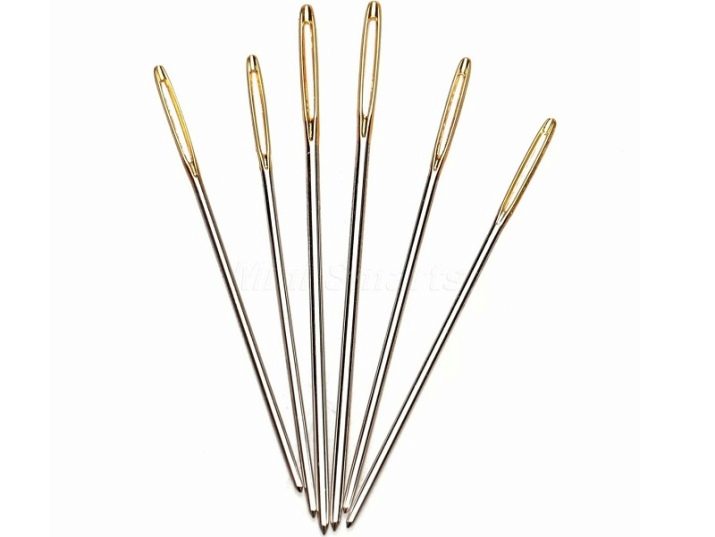
Advice! Sometimes sets appear on sale, the cost of which is an order of magnitude higher than similar ones. Most likely, the needles in them have a nickel coating - this makes them more durable, resistant to rust, acids and oils, that is, the best of their kind.
How can you store it?
Storing needles should be safe and comfortable. It is important that they are not covered with rust, they are always at hand of the craftswoman, but at the same time they are protected from children. To do this, use a needle bed - you can buy a ready-made one, or you can make it yourself from any materials at hand.
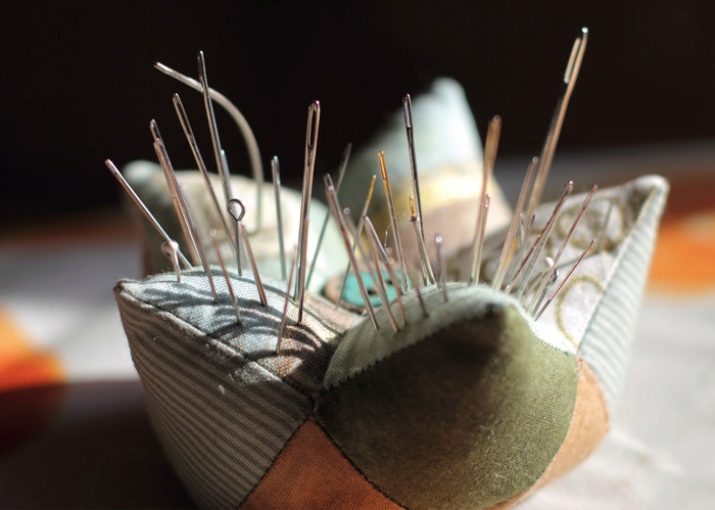
Here are just a few ideas.
- If you have an unnecessary porcelain cup in your house, place a small pillow stuffed with padding polyester or foam rubber in it. For the same purpose, you can take any other containers: plastic glasses, children's sand molds, a lipstick case.
- Alternatively, you can find a small saucer and use superglue to fix 2–4 magnets on the bottom. This way you can quickly and easily build an ergonomic magnetic needle bar.
